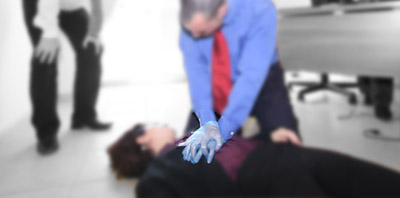FIRST AID IN THE WORKPLACE

Can you quickly and confidently handle an emergency at your workplace?
- In an office, a woman trips on a trailing lead from a computer, falls and knocks
her head. She is not breathing.
- A professional lorry driver is involved in a serious traffic accident resulting
in many people being injured. Some with serious bleeding,
some unconscious, some screaming and panicking.
- In a factory, some heavy machinery falls onto an employee and
crushes him.
- In a shop, a customer faints and collapses onto
the floor.
Employers and business owners beware!
- 504 workers in Greece suffered serious accidents between 2000 to
2006 and a further 549 fatalities were recorded in the same period.
- As an example, in the UK 28.5 million days were lost overall (1.2
days per worker), 23.4 million due to work-related ill health and 5.1 million due
to workplace injury. How much revenue is lost in your business due to employee injuries?
- The Hellenic Institute for occupational health and safety formed in 1992 held the
first Hellenic Occupation Health and Safety seminar in Nov 2010. Until Greece
catches up with the rest of Europe and implements major improvements
in health and safety policies at work then we should all consider first aid
training to deal with accidents and emergencies in the workplace.
These are just some examples of emergency situations
that happen all the time at work. Accidents in
the workplace are common place throughout the world resulting in all levels of injuries.
These range from sprains and strains, Back, Head & Neck injury and Repetitive Strain
Injury to more serious dehabilitating injuries such as permanent physical disability
or sudden cardiac
arrest.
Often these injuries are caused by trips, slips or falls, electrical incidents,
manual handling and lifting. Although proper health and safety
training can reduce these occurrences dramatically, having a
qualified First Aider on hand can make a massive difference to the recovery
of a casualty if an accident did occur.
If someone suffered an epileptic fit or suffered a spinal injury at your workplace,
would you know what to do?
If you had a heart attack would your colleagues know what
to do?
By becoming a qualified Emergency Responder you will be fully equipped to deal
with many different situations. From simply ensuring that someone is stable and
comfortable whilst waiting for emergency medical services, or managing an accident
scene and assessing injuries through to dealing with life threatening conditions
such as serious bleeding and spinal injuries. You will be confident in the skill
of CPR and use of an Automated External Defibrillator
(AED) for a casualty who is non-breathing and suffering from cardiac arrest.
Read more about our Basic Life Support CPR and AED Course.